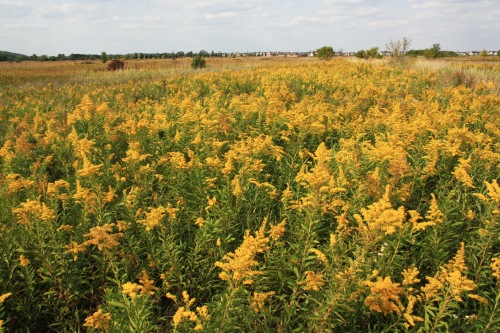Written by: Brenda Van Ryswyck, Natural Heritage Ecologist
Goldenrod can make a wonderful garden and wildlife plant! Sadly it has been branded negatively for many years now. One main negative concern is people believe goldenrods cause pollen allergies but this is a false assumption. Goldenrod pollen is sticky so it cannot cause allergies however it is often seen as the cause of allergies simply because it is the big showy flower we see when we are having the allergy symptoms. In reality it is the flower you DON’T see that you need to worry about.
The myth that goldenrod is responsible for seasonal allergies comes from the fact it blooms at the same time as ragweed. Ragweed is the cause of seasonal allergies in many people because it is wind pollinated. The pollen of ragweed is very light and becomes airborne easily, while the pollen of goldenrod is very sticky and cannot become airborne.
Goldenrod has its impressive, showy, bright flowers because it needs to attract pollinators (like bees and butterflies) to carry its pollen between flowers for pollination. Ragweed on the other hand does not need to attract pollinators so it has inconspicuous green flowers which most people do not even notice (and don’t really look like flowers at all); ragweed only needs a light wind for its pollen to become airborne and be blown to the next ragweed flower for pollination. Goldenrod on the other hand you can grab and shake and you will not see any pollen become airborne (and if you did happen to shake any loose it would fall straight to the ground).
Another thing some people find negative about goldenrod is its ability to spread rapidly and colonize new areas quickly. In the plant world this is a wonderful thing, giving the goldenrod a slight advantage in the ‘grow or die’ natural world. This is a benefit for wildlife though as these quickly colonizing plants will quickly stabilize the soil and its flowers provide essential nectar food for pollinators. In fact goldenrods (along with asters and other fall flowers) are essential for the Monarch butterfly as it makes its long migration. Patches of goldenrod and aster patches along their migration route provide lifesaving food to continue the journey. If you would like to provide nectar for pollinators in your garden, but do not want a plant that will aggressively spread, then try some of the more “well behaved” goldenrod species such as Blue-stemmed Goldenrod Solidago caesia, Zig-zag Goldenrod Solidago flexicaulis or Silverrod Solidago bicolor.
So don’t mow down that goldenrod patch! If you have ragweed allergies you may actually be making the situation worse as removing plants like goldenrod may open up the soil for fast growing ragweed to grow. Instead learn how to recognize ragweed and remove only it, leave the wonderful nectar of the goldenrod there for the Monarch and other pollinators. Enjoy the beauty of its golden blooms with the knowledge it is not contributing to your allergies, it is only contributing to biodiversity!





